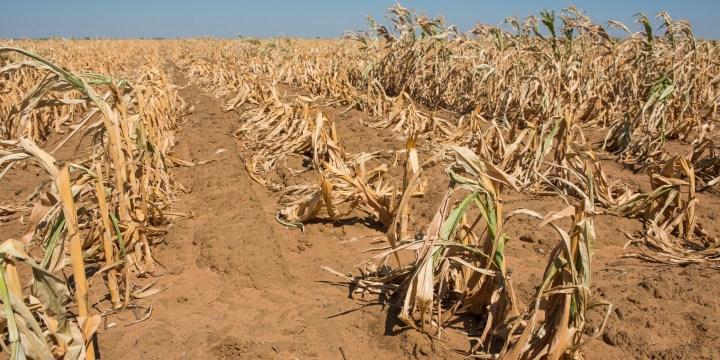EL NIÑO TOLL
South Africa’s neighbours bear the brunt of dry weather pattern

El Niño looks likely to fade, but it has scorched a path of misery across southern Africa.
The current El Niño weather event, one of the five strongest on record, according to the World Meteorological Organisation, is expected to fade soon. But its grim consequences will be felt in southern Africa for months to come.
Triggered by the periodic warming of surface temperatures in the eastern Pacific, El Niño typically heralds drought in this region, and the current event has been true to form.
From Zambia to Namibia and South Africa’s grain belt, El Niño is scorching a path of drought, hunger and misery across a region that is exceedingly vulnerable to extreme weather events.
The Kariba Dam is less than 17% full, threatening already erratic power supplies in Zimbabwe and Zambia.
Zambian President Hakainde Hichilema declared the drought a national disaster and emergency at the end of February, saying that one million hectares of the staple maize crop – out of 2.2 million planted – had been ruined by the dearth of rains.
South Africa has hardly been spared, but the drought appears not to have been as vicious locally, and the agricultural economies in the two countries offer a jarring juxtaposition.
In Zambia, 90% of agriculture is conducted by small-scale subsistence farmers who rely on rain. Agriculture accounts for 19% of its gross domestic product and employs 75% of the population, according to the US International Trade Administration, an agency in the Department of Commerce.
In South Africa, the vast majority of maize production is harvested by commercial farmers who have moved beyond even mechanisation to applications such as precision farming, which involves GPS technology to plant and apply inputs precisely. It is highly sophisticated and capital-intensive.
Largely as a result of this, El Niño is not cleaving the same ruinous path across South Africa’s summer grain belt, but not even cutting-edge technology can always compensate for the weather.
Crop estimates
In its initial forecast last month, the government’s crop estimates committee pegged this season’s maize crop to be 12.6% lower – about 14.35 million tonnes from 15.43 million tonnes last year.
Worryingly, the production of white maize – the key staple for South Africa and much of the region – was seen falling 17.2% to just over 7.04 million tonnes.
Estimates for both white and yellow maize (the latter used primarily for animal feed) are likely to be slashed when the committee releases its next forecast.
It will probably take a panga to the forecast for white maize as it is mostly grown in the west of South Africa’s grain belt, which has been far drier than the east. But the country is likely to still meet its own domestic needs for white maize consumption, helped by carry-over stocks from last year of more than one million tonnes.
Domestic white maize future prices are up about 25% over the past 12 months, which bodes ill for food inflation in South Africa at a time when it has been slowing.
The tragedy of this state of affairs – for a largely peasant economy such as Zambia’s – is that it will mean South Africa, the regional breadbasket, will have scant white maize supplies for export to its hungry neighbours, compounding their misery.
“Prices will go up, but in South Africa, it will have a relatively limited impact. But it’s going to be huge in the countries to the north. They are totally dependent on imports and they will be exposed to the full brunt of the drought,” Tobias Doyer, the chief executive of industry body Grain SA, told journalists at the organisation’s annual congress in Bothaville in the Free State on 13 March.
“When you have good food security, prices go up a little bit. When you have bad food security, they get out of hand,” he said.
Zimbabwe’s maize production may fall as much as 50% this season and its tobacco crop is predicted to fall to 235 million kilograms this season from a record 296 million kilograms last year.
Malawi will also not escape unscathed, though no official crop estimates have been published yet.
Elsewhere in the region, Namibia Rangelands, an online map portal that tracks soil and vegetation conditions in the arid country, shows in its latest update that more than half of Namibia is severely stressed. A year ago, far less of the country was shaded brown, which indicates severe conditions.
Dam levels
The UN’s Food and Agriculture Organisation said in early March that farming areas in Malawi, Mozambique, Namibia, Zambia and Zimbabwe had received only 80% of average rainfall from mid-November to February – the crucial period for maize and other summer crops.
But it’s not all doom and gloom. Dam levels in the region, for example, vary widely.
Whereas Kariba’s level is dangerously low, high up in the Lesotho highlands, the Katse Dam is more than 99% full, according to the latest update from South Africa’s Department of Water and Sanitation.
Katse’s waters are a key reservoir for Johannesburg and Gauteng, where the biggest immediate threat to water security is local government incompetence.
And, according to the World Meteorological Organisation, the current El Niño is expected to fade between April and June to “neutral conditions”, with a chance of its polar opposite, La Niña, developing later this year.
La Niña often brings drenching rains to southern Africa. The one from 2020 to 2023 was unusually prolonged. This meant much of the region had reasonably good soil moisture conditions when El Niño set in.
Such events are becoming more extreme because of human-induced climate change.
A return of La Niña and its rains will be welcome in this region. But it will take some time to wash away the parched legacy of the latest El Niño. DM
This story first appeared in our weekly Daily Maverick 168 newspaper, which is available countrywide for R29.





















 Become an Insider
Become an Insider
Polar opposite?